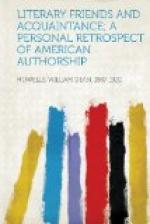“Who sees unmoved,
a ruin at his feet,
The lowliest home where
human hearts have beat?
Its hearth-stone, shaded
with the bistre stain,
A century’s showery
torrents wash in vain;
Its starving orchard
where the thistle blows,
And mossy trunks still
mark the broken rows;
Its chimney-loving poplar,
oftenest seen
Next an old roof, or
where a roof has been;
Its knot-grass, plantain,—all
the social weeds,
Man’s mute companions
following where he leads;
Its dwarfed pale flowers,
that show their straggling heads,
Sown by the wind from
grass-choked garden-beds;
Its woodbine creeping
where it used to climb;
Its roses breathing
of the olden time;
All the poor shows the
curious idler sees,
As life’s thin
shadows waste by slow degrees,
Till naught remains,
the saddening tale to tell,
Save home’s last
wrecks—the cellar and the
well!”
The poet’s chanting voice rose with a triumphant swell in the climax, and “There,” he said, “isn’t it so? The cellar and the well—they can’t be thrown down or burnt up; they are the human monuments that last longest and defy decay.” He rejoiced openly in the sympathy that recognized with him the divination of a most pathetic, most signal fact, and he repeated the last couplet again at our entreaty, glad to be entreated for it. I do not know whether all will agree with him concerning the relative importance of the lines, but I think all must feel the exquisite beauty of the picture to which they give the final touch.




